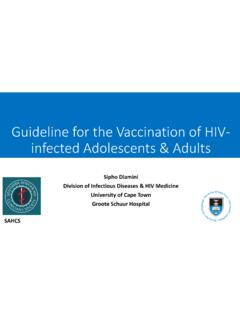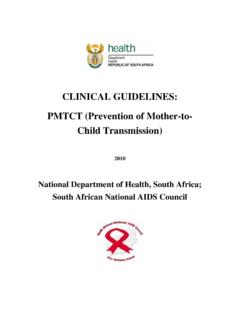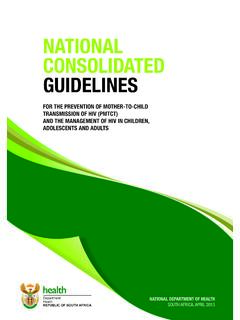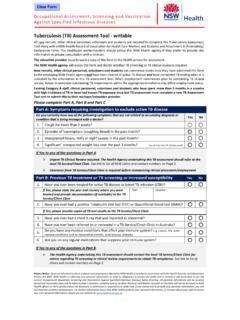Transcription of 2019 ART Clinical Guidelines - sahivsoc.org
1 2019 ART Clinical Guidelinesfor the Management of HIV in Adults, Pregnancy, Adolescents, Children, Infants and NeonatesPublished: October 2019 Republic of South Africa Na onal Department of Health ContentsForeword _____1 Overview _____2 The Goals of ART 2 ART Eligibility _____3 Medical Indications to Defer ART 3 ART Initiation _____4 Baseline Clinical Evaluation for Adults and Adolescents, Pregnant Women, and Children < 10 years 4 Baseline Laboratory Evaluation for Adults and Adolescents, Pregnant Women, and Children 6 Indications for Starting and Stopping Cotrimoxazole Preventive Therapy (CPT) 7TB Preventive Therapy 7 Dolutegravir 8 First-Line ART Regimens in Adults, Adolescents, Pregnant Women, Children, Infants, and Neonates 10Re-initiating ART in Clients who have Interrupted Treatment 11 Dual Treatment of HIV and Active TB in Neonates, Infants, Children, Adolescents and Adults 12 Managing the Client on ART _____13 Switching Stable Clients on ART Between First-Line Regimens 13 Monitoring on ART 15 Management of Viral Load Results in Infants, Children, Adolescents and Adults 16 Second-Line (2L) and Third-Line (3L)
2 ART Regimens _____17 Second-line ART Regimens for Adults with Confi rmed Virological Failure 17 Second and Third-line ART Regimens for Children and Adolescents with Confi rmed Virological Failure 17 Annexures _____18 Protocol for initiation of ART in HIV-infected neonates kg at birth 18 ARV Drug Dosing Chart for Children from birth - 28 days of age with birth weight kg 19 Antiretroviral Drug Dosing Chart for Children (2019) 20 Other Resources and Important Information _____22 Abbreviations _____2312019 ART Clinical GuidelinesForeword South Africa is commi ed to a aining the UNAIDS 909090 targets to control the HIV epidemic through quality comprehensive health services and use of highly eff ec ve an retroviral treatment (ART). The principal goal of ART is to a ain and maintain viral suppression, which will decrease morbidity and mortality from HIV as well as improve the quality of life for clients living with HIV. The 2019 HIV Clinical Guidelines have been revised to include a new formula on of the fi xed dose combina on (FDC) of Tenofovir (TDF) 300 mg + Lamivudine (3TC) 300 mg+ Dolutegravir (DTG) 50 mg (TLD) for all eligible adults, adolescents and children over the age of 10 years and weighing 35 kg or more.
3 This document is an abridged version of the Consolidated ART Guideline, intended to serve as a quick reference guide and job aid for healthcare workers . It intends to: Provide guidance on ini a ng na ve clients on DTG-containing regimens Provide guidance on switching exis ng clients on ART to DTG-containing regimens Highlight cri cal areas for the provision of integrated ART, TB and family planning services Provide guidance on second and third line regimens in the era of advantages of DTG is that it has a high gene c barrier to resistance, minimal side eff ects and drug interac ons, and provides rapid viral suppression. It is well tolerated by pa ents and expected to contribute posi vely to adherence and reten on on ART. Implementa on of these Guidelines will increase access to ART services, advance South Africa s ability to control the epidemic and help to achieve the 2030 SDG goals. I would like to thank all the internal and external stakeholders who ac vely contributed to the development of these is our sincere wish that clinicians at all health care facili es across the board will use these Guidelines to off er quality, comprehensive services to the public.
4 Dr Zweli MkhizeMinister of Health22019 ART Clinical Guidelines Overview This ART Clinical Guideline is intended to serve as a quick reference guide for an retroviral treatment (ART) in adults, pregnant women, adolescents and paediatric clients, and as a job aide for healthcare workers and implemen ng partners. This document is not intended to be exhaus ve; for more informa on or details on any recommenda ons, or on the preven on of mother-to-child transmission, please refer to the comprehensive Consolidated HIV Guidelines document and the Guideline for the Preven on of Mother to Child Transmission of Communicable Infec ons (HIV, Hepa s, Listeriosis, Malaria, Syphilis and TB) objec ves of this document are to: Provide guidance on ini a on of ART in an retroviral-na ve clients as well as those returning to care in the era of dolutegravir (DTG) Provide guidance for switching of clients already on ART to DTG-containing regimens Highlight cri cal areas for provision of integrated ART, TB, and family planning people either currently on ART, or newly ini ated on ART, should be screened for TB and assessed for TB preven ve therapy (TPT) as preferred fi rst-line ART regimen is tenofovir disoproxil fumarate-lamivudine-dolutegravir (TLD) for those clients ini a ng ART, experiencing side-eff ects to EFV, or for those who prefer to use DTG a er being given all the necessary informa on.
5 However, due to concerns around safety of TLD in the fi rst fi rst 6 weeks of pregnancy, tenofovir disoproxil fumarate-emtricitabine-efavirenz (TEE) is recommended for women of childbearing poten al wan ng to conceive. For this reason, integra on of family planning and ART services are of paramount importance, and issues of family planning and contracep on should be discussed at every Clinical interac on to understand the client s current fer lity desires and healthcare needs. The guideline broadly follows the process of care, namely: 1) ART eligibility and determining the meframe for ART ini a on2) ART ini a on3) Management of the client on ART 4) Second and third-line ART the aim to: Decrease opportunis c infec ons and other HIV-related condi ons Minimise the development of treatment resistance Decrease the morbidity and mortality from HIV/AIDS Improve quality of lifeAchieve and Maintain Virological SuppressionThe Goals of ARTM anagement of the Client on ART Switching stable clients on ART to new fi rst-line regimens Monitoring a client on ART Management of VL resultsART Initiation Baseline Clinical evalua on Baseline laboratory evalua on Dolutegravir First-line ART regimens Dual treatment for HIV and TBART Eligibility and Determining the Timeframe for ART Initiation Who is eligible?
6 Reasons to defer ART Second and Third-line A R T Regimens32019 ART Clinical Guidelines ART Eligibility All people living with HIV (PLHIV) are eligible to start ART regardless of age, CD4 cell count and Clinical all clients without contra-indica ons, ART should be ini ated within 7 days, and on the same day if possible. Pregnant women, infants and children under fi ve years, and clients with advanced HIV disease should be priori sed for rapid ini a on. Certain clients (including pregnant women) may be able to ini ate ART on the same day as their HIV diagnosis, provided that they are clinically well, and are mo vated to start ART. While rapid, and same-day where possible, ini a on is encouraged, all clients, par cularly those with advanced HIV disease, should be carefully assessed for opportunis c infec ons that may necessitate ART Indicati ons to Defer ARTM edical Indications to Defer ART IndicationActionTB symptoms (cough, night sweats, fever, recent weight loss) Inves gate for TB before ini a ng ART.
7 If TB is excluded, proceed with ART ini a on and TB preven ve therapy (a er excluding contra-indica ons to TPT). If TB is diagnosed, ini ate TB treatment and defer ART. The ming of ART ini a on will be determined by the site of TB infec on and the client s CD4 cell countDiagnosis of drug-sensi ve (DS) TBat a non-neurological site ( TB, abdominal TB, or TBlymphadeni s)Defer ART ini a on as follows: If CD4 < 50 cells/ L ini ate ART within 2 weeks of star ng TB treatment, when the client s symptoms are improving, and TB treatment is tolerated If CD4 50 cells/ L ini ate ART 8 weeks a er star ng TB treatmentDiagnosis of drug-resistant (DR) TB at a non-neurological site ( TB, abdominal TB, or TBlymphadeni s)Ini ate ART a er 2 weeks of TB treatment, when the client s symptoms are improving, and TB treatment is toleratedDiagnosis of DS-TB or DR-TB at a neurological site ( TB meningi s or tuberculoma)Defer ART un l 4-8 weeks a er start of TB treatmentSigns and symptoms of meningi sInves gate for meningi s before star ng ARTC ryptococcal an gen (CrAg) posi ve in the absence of symptoms or signs of meningi sDefer ART un l the fi rst 2 weeks of fl uconazole prophylaxis has been completedConfi rmed cryptococcal meningi sDefer ART un l 4-6 weeks of an fungal treatment has been completedOther acute illnesses Pneumocysti s jirovecii pneumonia (PJP)
8 Or bacterial pneumoniaDefer ART for 1-2 weeks a er commencing treatment for the infec on Clinical symptoms or signs of liver diseaseConfi rm liver injury using ALT and total bilirubin levels. ALT eleva ons > 120 IU/L with symptoms of hepa s, and/or total serum bilirubin concentra ons > 40 mol/L are signifi cant. Inves gate and manage possible causes including hepa s B, drug-induced liver injury (DILI), or alcohol abuseNote: Clients who are already on ART should NOT have their treatment interrupted upon diagnosis of the above condi ons42019 ART Clinical Guidelines ART Ini a on A Clinical assessment and laboratory baseline inves ga ons should be done in order to ini ate ART. However, laboratory results do not need to be available to start clients on ART on the same day, provided they have no Clinical evidence of TB, meningi s or renal disease. In addi on, all clients, and caregivers of paediatric clients, must receive counselling on how to administer medica on, monitor side-eff ects and deal with challenges to Clinical Evaluati on for Adults and Adolescents, Pregnant Women, and Children < 10 yearsThe baseline Clinical evalua on of a client about to start ART requires a thorough history and Clinical examina on.
9 The minimum components of the baseline Clinical evalua on are outlined in the table of the Baseline Clinical EvaluationPurposeFurther Action RequiredAdolescents (10-19 years) and AdultsPregnant WomenChildren (< 10 years)Recognise the client with respiratory, neurological, or abdominal danger signs needing urgent careTo iden fy opportunis c infec ons and condi ons needing urgent care or referralIden fy respiratory, neurological, or abdominal danger signs as outlined in Adult Primary Care (APC) guidelineIden fy danger signs as outlined in the Maternity Care guidelinesIden fy danger signs as classifi ed in the IMCI Chart bookletNutri onal AssessmentTo iden fy recent weight loss that may indicate an ac ve opportunis c infec on (OI) or other pathology. To iden fy underweight/obese clients requiring nutri onal and lifestyle supportMeasure weight and height and determine BMI (kg/m2): < = underweight; to 25 = normal; > 25 to < 30 = overweight.
10 30 = obeseMeasure mid upper arm circumference (MUAC)Women with MUAC < 23 cm require addi onal nutri onal support/referralPlot weight, height and head circumference (if < 2 years) on growth chart, and measure MUAC to iden fy moderate and severe malnutri onScreen for TB To iden fy clients with a posi ve TB screen who require further inves ga ons for TB To iden fy clients with a nega ve TB screen who may be eligible for TPT (see page 7)Iden fy symptoms of cough, night sweats, fever, recent weight loss as outlined in the TB screening toolDo a TB symptom screen and TB GeneXpert for all HIV-posi ve women at fi rst visit in antenatal clinic, due to the lower sensi vity of the TB symptom screen in pregnant womenIden fy symptoms of cough, night sweats, fever, recent weight loss as outlined in the TB screening toolScreen for symptoms of meningi sTo diagnose and treat clients with cryptococcal and other forms of meningi s and reduce associated morbidity and mortalityIden fy symptoms of headache, confusion or visual disturbances.














